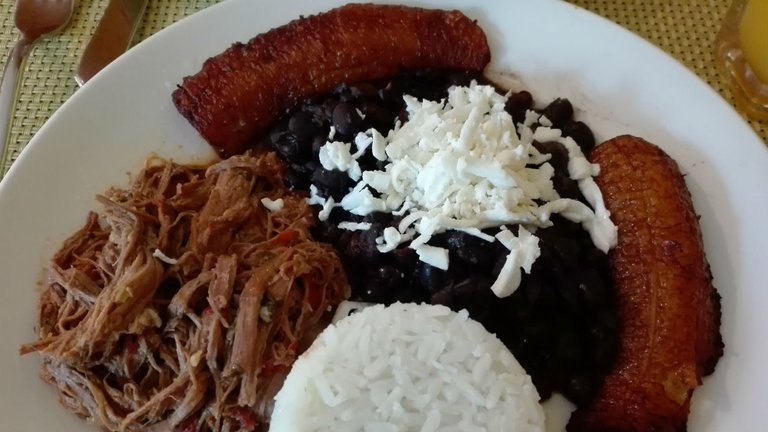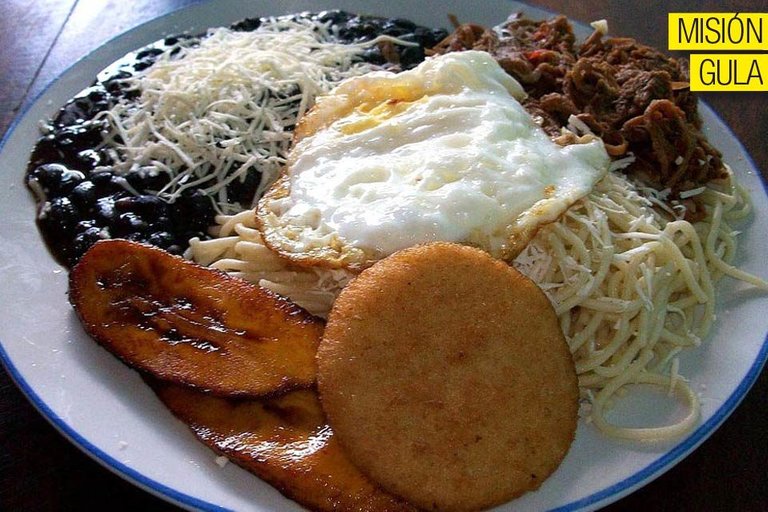
Hola Hiver’s, hoy les vengo a contar sobre una comida emblemática de mi país el cual es uno de los más ricos y representativos de mi país, el cual quería compartir. Puede variar un poco dependiendo de la región pero la base del plato siempre es la misma. Empecemos con lo que es el pabellón.
Hello Hiver’s, today I come to tell you about an emblematic meal of my country which is one of the richest and most representative of my country, which I wanted to share. It may vary a bit depending on the region but the base of the dish is always the same. Let's start with what the pavilion is.

The pabellón or also known as pabellón criollo, is a traditional dish of Venezuelan origin, which was created in colonial times by the slaves themselves, which consisted of the leftovers left from previous days made by them on the haciendas. One hypothesis says that this originated specifically in the central western region, where it is easier to get the ingredients since it connects with the plains, the Caribbean, the Andes mountain range, Lake Maracaibo, which are very rich climates. in the agriculture.

Being a dish made from ingredients already made, it could be said that it is a "reheated" dish, which traditionally consists of white rice, shredded meat "refried" beans (that is, fried beans) and slices of fried ripe plantain. . Being a dish that spread throughout the country, in each region there is a variation which I will tell below:

- “Pabellón a Caballo”: en el cual a plato tradicional se le agrega un huevo de gallina frito.
- “Pabellón a Caballo”: in which a fried chicken egg is added to a traditional dish.

- “Pabellón con Arepas”: normalmente se come en el desayuno, y consiste en sustituir el arroz blanco por arepas, además se puede acompañar con queso blanco rallado, aguacate con sal e incluso hasta huevos revueltos.
- “Pabellón con Arepas”: it is usually eaten for breakfast, and consists of substituting arepas for white rice, it can also be served with grated white cheese, salted avocado and even scrambled eggs.
- “Pabellón Vegetariano”: al ser un plato orientado a las personas que no comen carne, ya que se sustituye la carne mechada por berenjenas. Otra alternativa consiste en tiras finas de la cascara de un plátano pintón (entre verde y maduro), el cual es hervido y sofreírlas, el cual si es bien preparado no se diferencia mucho de la carne real.
- “Pabellón Vegetariano”: being a dish aimed at people who do not eat meat, since shredded meat is replaced by aubergines. Another alternative consists of thin strips of the peel of a pretty banana (between green and ripe), which is boiled and fried, which if well prepared does not differ much from real meat.

- En los Llanos se suele rayar queso blanco sobre las tajadas, caraotas. Además de hacer la carne mechada con animales de casa como venado, chigüire o lapa.
- In the Llanos white cheese is usually scratched on the slices, beans. In addition to making shredded meat with house animals such as venison, chigüire or limpet.
- “Pabellón Alterado”: de la región occidental y los llanos centrales, en donde en ocasiones se sustituye el arroz por espagueti y se acompaña con un huevo frito.
- "Pabellón Alterado": from the western region and the central plains, where rice is sometimes substituted for spaghetti and served with a fried egg.

- “Pabellón Margariteño”: en Oriente y la costa a las caraotas se les agrega azúcar y en algunas ocasiones a la carne mechada se le sustituye por pescado o mariscos preparados de la misma forma.
- “Margariteño Pavilion”: in the East and on the coast, sugar is added to the beans and on some occasions the shredded meat is replaced by fish or shellfish prepared in the same way.
- En la región de los Andes y el Zulia se usan “tostones”, el cual es plátano verde frito. Además que en el Zulia la carne mechada se suele preparar con coco.
- In the Andes and Zulia regions, "tostones" are used, which is fried green plantain. Also, in Zulia, shredded meat is usually prepared with coconut.
- También existe una variante poco común en donde las tajadas de plátano se sustituyen por plátano maduro horneado o asado, el cual se esparce por encima con queso blanco duro rallado. Otra variante también poco común es cambiar la carne mechada por carne molida guisada.
- There is also a rare variant where banana slices are substituted for baked or roasted ripe plantain, topped with grated hard white cheese. Another rare variant is to change the shredded meat for stewed ground meat.

Este es un plato que he comido desde mi niñez y forma parte de los buenos recuerdos que tengo con mi familia es al comer este tipo de platillos típico de mi país. Un plato muy representativo de la riqueza gastronómica que tiene mi país y de la cual estoy muy orgulloso.
This is a dish that I have eaten since my childhood and it is part of the good memories I have with my family is when I eat this type of typical dishes from my country. A very representative dish of the gastronomic wealth that my country has and of which I am very proud.

Fuente Información / Information Source
+https://es.wikipedia.org/wiki/Pabellón_criollo
Fuentes de Imagenes / Image Sources
+https://www.misrevistas.com/estampas/notas/2627/hablemos-de-nuestro-pabellon-criollo
+https://correodelara.com/el-pabellon-criollo-plato-nacional-venezolano/
+https://laollavegetariana.blogspot.com/2018/04/pabellon-criollo-vegetariano.html
+https://talcualdigital.com/pabellon-con-pasta-no-es-pabellon-por-miro-popic/